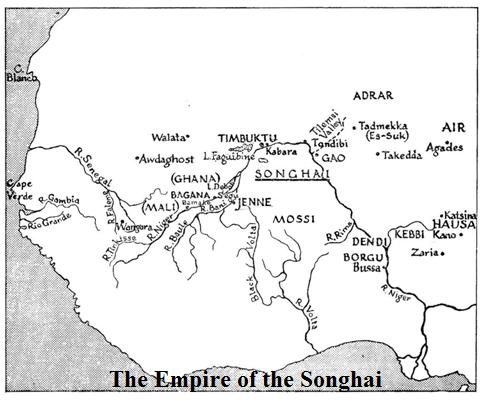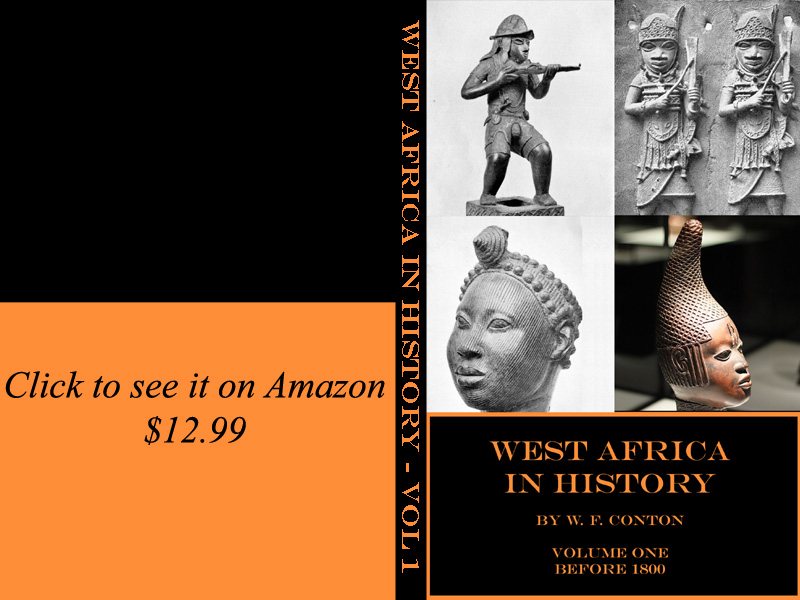…Further downstream, just round the sweeping northern bend of the Niger, is another ancient monument that deserves to be much better known than it is, and which, like the Sankore mosque, I hope you will be able to visit some day. It is the tomb of the Askias, Emperors of the Songhai people; and it is to be found at Gao or Gaw-Gaw, their ancient capital. This tomb is a massive, rather unattractive, but compact building, set, like the mosque at Timbuktu, in semi-desert country, which is clothed only in scrubby grass and low trees. This once proud city, mistress of a vast domain, is today little more than the market and meeting ground of nomadic and semi-nomadic tribes, and a convenient ford. The only feature of the landscape that has remained unchanged for the past thousand years is the camel, still kneeling obediently to let his master mount and dismount, still loping along with his ungainly stride.
But at least we do know the approximate boundaries of this Empire, and the precise situation of its capital. So we have been able to discover quite a lot about it and its rulers. The Songhai people probably came originally from the area where the Rivers Rima and Niger meet The eastern boundaries of their Empire stretched, at their most extensive, as far as Bussa in the south, and Kano in the north. And Gao you will find clearly marked on most modern maps of West Africa, for a busy town still exists there today.
The Songhai did not choose this particular spot for their capital by chance. You will remember how in our second chapter I remarked on the importance of easy communications and fertile soil if human civilization is to develop in any part of the world. History teaches us clearly that a primitive man is not an inferior man, but an isolated one; and that civilized man is not a superior one, but an accessible one. In the middle Niger, as in the Euphrates and Nile, we have an excellent example of fertile land giving the people living on it both the leisure and the contacts (with other peoples also attracted by the soil’s fertility) which are necessary for progress.
 If you find Bamako and Bussa on the
Niger, and look at the
stretch of river between them, you will be looking at a thousand miles
of waterway which is uninterrupted by falls or rapids: The river banks
are lined by a water grass called borgu which cattle love, and by the
fan palm tree, whose trunk makes such excellent canoes. At both ends of
this peaceful pasturage there are rapids which help to make it easily
defended against undesirable visitors, and along its whole length there
are picturesque islands and inlets.
If you find Bamako and Bussa on the
Niger, and look at the
stretch of river between them, you will be looking at a thousand miles
of waterway which is uninterrupted by falls or rapids: The river banks
are lined by a water grass called borgu which cattle love, and by the
fan palm tree, whose trunk makes such excellent canoes. At both ends of
this peaceful pasturage there are rapids which help to make it easily
defended against undesirable visitors, and along its whole length there
are picturesque islands and inlets.It is not surprising, therefore, that this stretch of the Niger should have been at one time or another the home of some of the most energetic and well-organized tribes in West Africa. It was a very desirable piece of country, and only the strongest of tribes could make it its own for any great length of time. And the strongest tribe of all seized the most desirable spot of all, where the long Tilemsi valley carrying a trade route from North Africa south-westwards across the Sahara reached the Niger.
It was here on the northern bank of the Niger, at Gao, one
of the most important cross-roads of West Africa, that the negro
Songhai had settled about the seventh century…The Songhai were in the
eighth century a completely pagan tribe, of course; for Islam had not
yet reached West Africa. When it did, 300 years later, it was through
the Lemta Tuareg that the Songhai received the new faith. The Za line
of Emperors was still ruling but was now, through frequent
intermarriage, at least partly negro…The city which ranked second to
Gao in importance in Songhai was to the west - Timbuktu, not much more
than 200 miles away as the crow flies, but much further if you followed
the winding northern sweep of the mighty river. With both the eastern
and the western trade routes you have drawn within easy reach of it,
Timbuktu can be said to have remained for several centuries the
commercial capital of West Africa. Here the salt from Taghaza, the gold
dust from Jenne and Wangara, and the fish from Kabara (Timbuktu’s
little port) changed hands, and wealth multiplied. The original tents
of Timbuktu soon gave way to huts; and although it was Es-Saheli’s
mosque in Gao which first used burnt bricks, Timbuktu soon started to
use this new building material too. The foundations of these original
brick buildings may be seen in both towns today; and there are brick
buildings of similar style standing in Timbuktu now… It was at Timbuktu
that the great university and mosque of Sankore were established, to
which men of letters came from far beyond the coasts of Africa. It was
essentially a Muslim university, with great historians such as Ahmed
Baba and architects and poets such as Es-Saheli (whom we have already
met) working there. But it was also a truly African university. Arabic
was the social lingua franca, but Songhai seems to have been used as
the medium of teaching and research. Degrees were awarded to the best
students, and we know that the academic standards reached were at least
as high as those of the better-known North African universities. In
fact we read of one scholar from one of the latter institutions who
came to Timbuktu hoping to be appointed a lecturer, and decided to stay
there as a student…The historian Leo Africanus tells us how in Timbuktu
in this reign there were ‘many judges, doctors and priests, all
receiving salaries from the king. He pays great respect to men of
learning. There is a big demand for books in manuscript…’
…And so Askia the Great drew to the end of a very prosperous reign. He still had to face many difficulties before it finally ended. First Kanta, King of Kebbi (one of the Hausa states we are to study in the next chapter) rebelled successfully against him. Surame, Kanta’s capital, was so secure behind its seven stone walls that Kanta and his successors henceforth maintained their independence not only from the Songhai, but also from Bornu and Sokoto…The old ex-Emperor was now almost ninety; but perhaps these rather sad closing years of his life were cheered by one bright item of news. When he had conquered the Tuareg many years before, Askia had cleared the town of Berbers, and planted in it a community of Songhai. This small and isolated community has frequently been attacked by Berbers since, and many of its members have inter-married with non-negroes. But the settlement succeeded in beating off all attackers. Askia was able to follow its fortunes with great satisfaction from his exile; and, since it still survives today, this little negro colony in Berber territory provides an opportunity, particularly to pupils in Northern Nigeria, to visit a living memorial to a great ruler…
NEXT(The
Bornu and Hausa States)
PREVIOUS(The
Empire of Mali)
